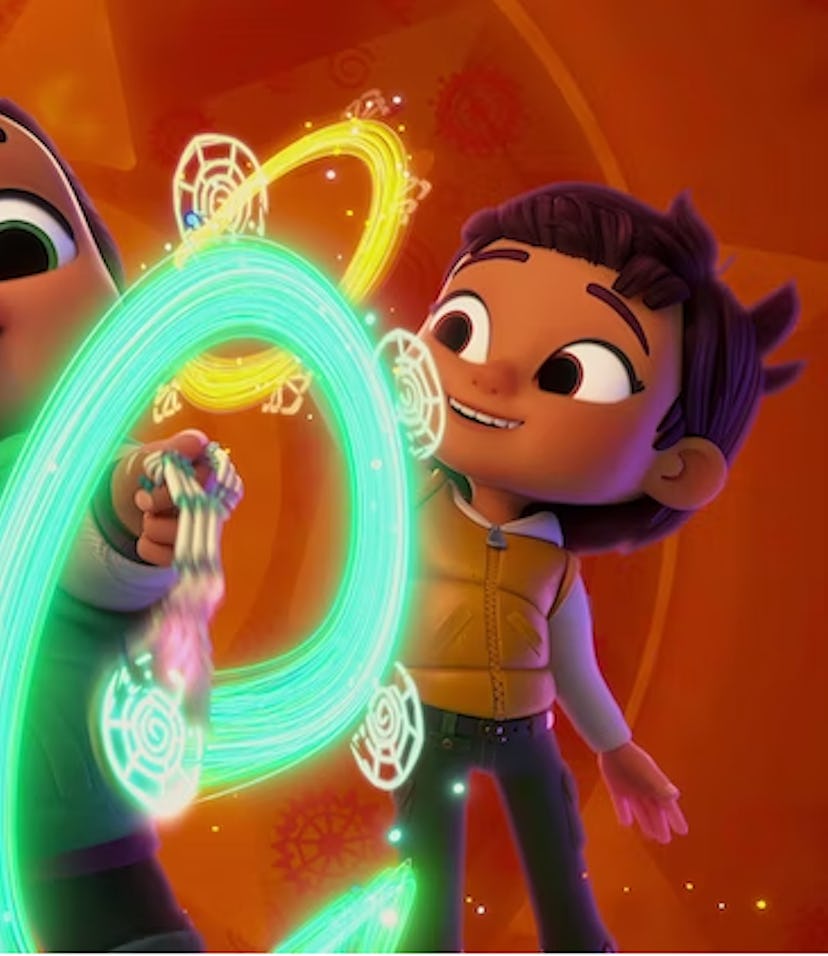Exclusive

Spirit Rangers On Netflix Is A Love Letter To Native Cultures & National Parks
Creator Karissa Valencia talks about the importance of sharing old stories with contemporary characters.
Karissa Valencia, the creator of Netflix’s new preschool series Spirit Rangers, grew up hearing the traditional stories of her Chumash culture. How the condor got its black feathers, why the sun is in the sky, how Lizard gave humans hands that looks like hers. But she’s also a self-proclaimed ‘90s baby who enjoyed a steady diet of Gargoyles, Rugrats, and all things Disney. Representation of Native characters and stories were (and remain) fairly rare, and it was exciting when she was able to see characters that looked like her, and her favorite was Disney’s Pocahontas. So when Irene Bedard, the Iñupiat/Cree actress who voiced the titular character, showed up at a powwow she attended as a kid, she was ecstatic.
“I was like, ‘Oh, my God, she looks like me and my sister. There she is! She looks like her character!’” Valencia tells Romper. “It meant everything to me to see that she looked like her character and was Native.” But as she got older, Valencia realized the story in her beloved cartoon was a “romanticized version of this horrible, horrible story.” “Pocahontas” wasn’t even the Powhatan girl’s name (it was Amonute, or Matoaka more intimately). Representation matters, she realized, but not just on-screen. “It was like, ‘Oh, my God: I need to be behind the camera to make those changes.”
Spirit Rangers, she says, is a show she wished she could have had as a child. It tells the story of the Chumash and Cowlitz Skycedar family. While Mom and Dad work as rangers in the fictional Xus National Park, siblings Kodi, Summer, and Eddy can see the spirit inhabitants of the land. (Traditional folkloric figures Coyote and Lizard are usually close at hand, but Thunderbirds, condors, bats, and others are known to make an appearance.) With the magic of their traditional Chumash T’aya necklaces, the children transform (in a sequence inspired in part by Sailor Moon, she says) into spirit counterparts — a grizzly cub, a red-tailed hawk and a turtle — to defend their park (both the park everyone can see and the more esoteric “Spirit Park”) as Spirit Rangers.
Valencia describes the series as a “love letter” to nature and National Parks. (Even though she jokes that, as an “urban Native ... when I camp it’s mainly glamping.”) The show’s depiction of the natural world is inexorably tied to its depiction of the spirit world, something her team drew from Indigenous philosophy. “There is this idea of reciprocity, but also that resources aren't there as resources,” she explains. “I always wanted to have that shine through, that we're connected with nature. It's not separate from us.”
The details in the show draw from traditional stories, but the characters, and the way they are portrayed, are all explicitly contemporary. While the children may don regalia for special occasions, their everyday clothes are things any kid today would play in outdoors. Their Spirit Park treehouse is based on traditional Chumash architecture, but includes plenty of 21st century details as well. The story of how Bat got his wings is an old one, but the “Disney-esque” music gives it a new life; the treatment European fairy tales from the Brothers Grimm and Hans Christian Anderson have enjoyed for nearly a century.
“It was just exciting for me that Natives can also kind of have that Disney type of song and story,” she says. “It doesn't always have to be sad songs! You can also have silly cartoon songs.” The synthesis of tradition and modern-life is intentional; a way to show what it means to be Native today.
Valencia specifically reached out to the Chumash and Cowlitz tribes for their blessing to affiliate the Skycedars with their communities (and draw from their traditions and stories). While other series have fictionalized tribes (often out of respect), specificity was important to her. “There's so much work to be done in visibility for all different tribes,” she explains. “So having a kid say ‘I'm Chumash; I'm also Cowlitz,’ was also exciting for me because growing up with little Native representation, when we did it was always the Plains Natives or the Northeast.
“Even still some of our Chumash kids are like, ‘Did we live in tepees?’” she laughs. “It's like, ‘No! You didn't!’ But that's what they're seeing on TV.”
While Chumash and Cowlitz cultures influenced many of the characters and storylines, Spirit Rangers finds inspiration from a wide variety of Indigenous cultures, owing in large part to the diversity in the writing room, which reflects the vibrant variety of Native communities throughout North America.
“I am not Queen Native of everything, so I really wanted to have multiple Natives in the room because I'm not the only perspective,” Valencia says. “I've learned so much. It's been the American history class I always wish I got to take. I'm just forever grateful for this team who took the time to explore what it was like for them to be a Native kid and what were the shows they wished they saw.”
In the end, telling traditional stories through a contemporary lens — with the help of Native talent, from writers, actors, consultants, and more — has been a joyful and healing journey for Valencia. “Growing up, being spoken about in the past tense [as a Chumash child] made me feel invisible,” she says. “[Native stories on-screen] were always Native kids in the past tense. Those stories are great for other reasons, but I just am so desperate to even see myself on screen. This is totally healing that inner child.”